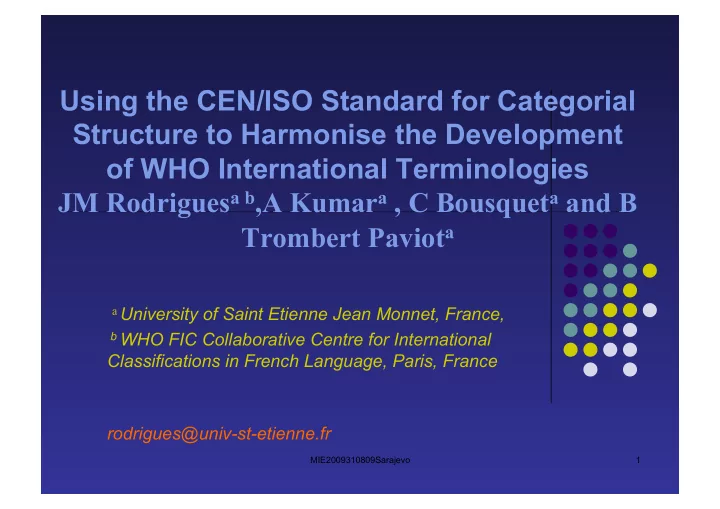

Using the CEN/ISO Standard for Categorial Structure to Harmonise the Development of WHO International Terminologies JM Rodrigues a b ,A Kumar a , C Bousquet a and B Trombert Paviot a a University of Saint Etienne Jean Monnet, France, b WHO FIC Collaborative Centre for International Classifications in French Language, Paris, France rodrigues@univ-st-etienne.fr MIE2009310809Sarajevo 1
Harmonising International Terminologies 1 Introduction 2 WHO ICD 11 Revision 3 Categorial Structure Approach 4 Conclusion : Other International terminologies MIE2009310809Sarajevo 2
DEFINITIONS 1 Semantic (content)interoperability a dream? the ability for information shared by systems to be understood at the level of formally defined entities, so that the receiving system can process the information effectively and safely 2 Healthcare Terminological systems: from divergence to harmonisation? set of designations within the domain of health care with, when appropriate, any associated rules, relationships and definitions. (ISO 1087 and ISO 17115:Terminologies and Classifications ) WHO FIC (ICD 11, ICF,ICHI, ICPS, ICNP et.) IHTSDO (Snomed CT) Standards (CEN ISO 1828, ISO 18104, ISO 17115, CEN 12264 et.) MIE2009310809Sarajevo 3
DEFINITIONS 3 Categorial Structure approach: A lite ontology: Based on Ontology principles or models (e.g FMA for CEN 15521) Not constraining very much sytem developers and linguistic expressiveness Evolving each 5 years to more formalism To bind Terminologies to Ontologies 4 WHO-FIC new cooperative web-based joint authoring process to revise and develop International Classifications. MIE2009310809Sarajevo 4
Harmonising International Terminologies 1 Introduction 2 WHO ICD 11 Revision 3 Categorial Structure Approach 4 Conclusion MIE2009310809Sarajevo 5
ICD 11 revision iCamp: 22 Sept 2009 - 2 Oct 2009 Alpha Draft: 3 Oct 2009 - 10 May 2010 Phase I: 3 Oct 2009 - 13 Dec 2009 Interim Review: 13 Dec 2009 - 18 Jan 2010 Phase II: 18 Jan 2010 - 10 May 2010 Alpha Draft Complete: 10 May 2010 Beta I Draft Complete: 10 May 2011 Beta II Draft Complete: 10 May 2012 (Field Trials Begin Submission to WHA Nov 2013 WHA Approval May 2014 ICD-11 Implementation /continuous update Jan. 2015 onwards MIE2009310809Sarajevo 6
ICD 11 Revision Organisation 1 TAG Managing Editors ‐proposal generator, ‐reviewer, ‐managing editor.. 2 Classi4ication Experts (WHO‐FIC Collaborating centres+ WONCA) ‐ validation of the linearization (ICD10 +national adaptations +specialties WHO lexica, other (rare disease,UMLS,SnomedCT et.. ‐ coding rules and instructions (Volume II) and index (Volume III). 3 Informatics experts ‐ tooling ‐ workPlows ‐ multilingual aspects of the tooling and the products. 4 Social Networking for Beta phase MIE2009310809Sarajevo 7
ICD 11 revision TOOLS 1Software ICAT (Initial Collaborative Authoring Tool) - Collaborative Protégé - Bioportal - Browser 2 Content model :4 dimensions layer -Ontology layer - -Foundational layer (Diagnosis morbidity criteria) - - Linearisation layer (3 uses cases :mortality, morbidity, - primary care) - Lexical/multilingual layer - 3 Common Template to identify the semantic components of diseases definitions and their values starting from the content model(categorial structure) MIE2009310809Sarajevo 8
Terminology to Ontology through standards 1 Introduction 2 WHO ICD 11 Revision 3 Categorial Structure Approach 4 Conclusion MIE2009310809Sarajevo 9
Definition Categorial structure for healthcare terminologies: Minimal set of domain constraints to represent a healthcare terminology in a precise domain with a precise goal . a)list of semantic categories :Owl classes in Protégé b)goal of the categorial structure c) list of semantic links authorised with their associated semantic categories: Owl properties in Protégé d)minimal constraints allowing the generation and validation of well formed terminological phrases . Content model. 3 different uses cases MIE2009310809Sarajevo 10 10
DISEASE MORTALITY MIE2009310809Sarajevo 11 11
DIAGNOSTIC MORBIDITY MIE2009310809Sarajevo 12 12
PATIENT FINDINGS AND PROBLEMS PRIMARY CARE MIE2009310809Sarajevo 13 13
Disease/Diagnostic:has_abnormality MIE2009310809Sarajevo 14 14
Diagnostic.Has_Characteristics MIE2009310809Sarajevo 15 15
Disease.Has_Etiology MIE2009310809Sarajevo 16 16
Disease/Disorder.Has_Findings MIE2009310809Sarajevo 17 17
Patient Findings and Problems.Has_Focus MIE2009310809Sarajevo 18 18
Disease/Disorder.Has_Location MIE2009310809Sarajevo 19 19
Terminology to Ontology through standards 1 Introduction 2 WHO ICD 11 Revision 3 Categorial Structure Approach 4 Conclusion:Other International Terminologies MIE2009310809Sarajevo 20
ICD 11 revision process is a critical shift based on a new organisation new tools available in biomedical informatics and in the web open source community. Web social cooperation and ontology driven tools are the means to increase semantic interoperability with other international terminologies within the WHO FIC network (ICF, ICHI and ICPS) and outside (IHTSDO and SNOMED CT). 3 Different linearisations/uses cases MIE2009310809Sarajevo 21 21
ICHI MIE2009310809Sarajevo 22 22
ICF MIE2009310809Sarajevo 23 23
ICPS Incident MIE2009310809Sarajevo 24 24
ICPS Action MIE2009310809Sarajevo 25 25
ACKNOWLEDGEMENTS Department of Classification, Terminology and Standards from the Health Statistics and Informatics division WHO headquarters Geneva Dr Bedirhan Ustun coordinator WHO FIC collaborating centres HIM TAG partners CEN TC251 WG2 and ISO TC 215 WG 3 MIE2009310809Sarajevo 26 26
MIE2009310809Sarajevo 27
Recommend
More recommend